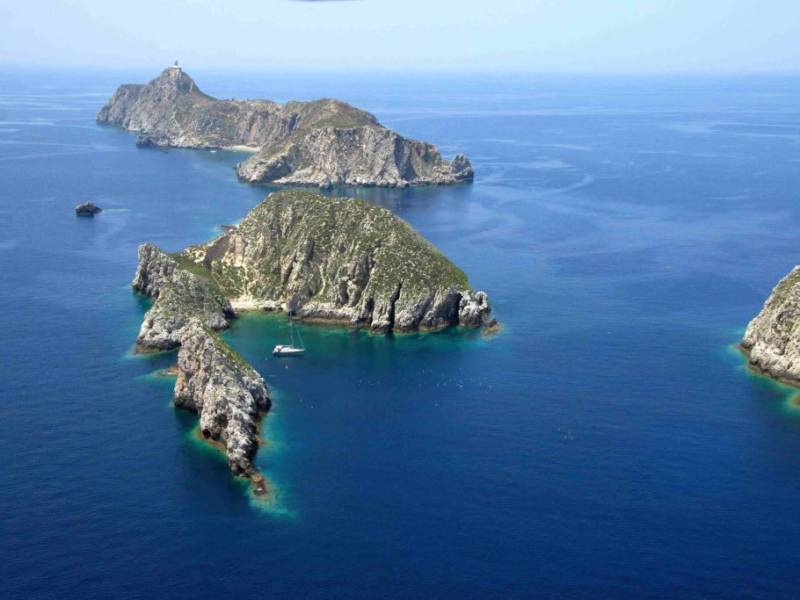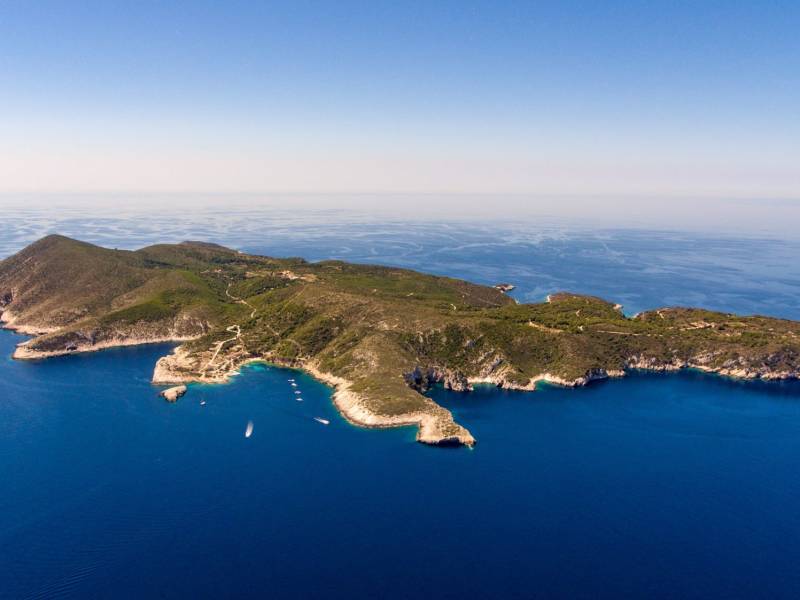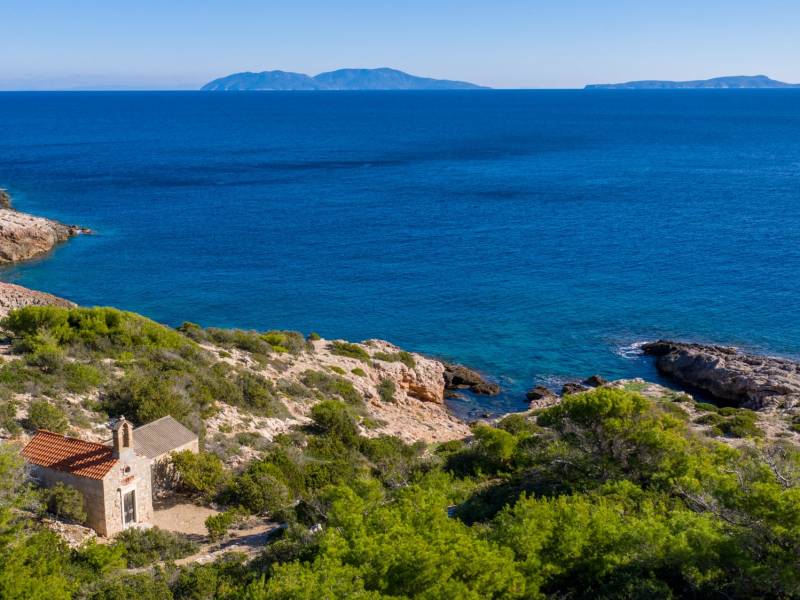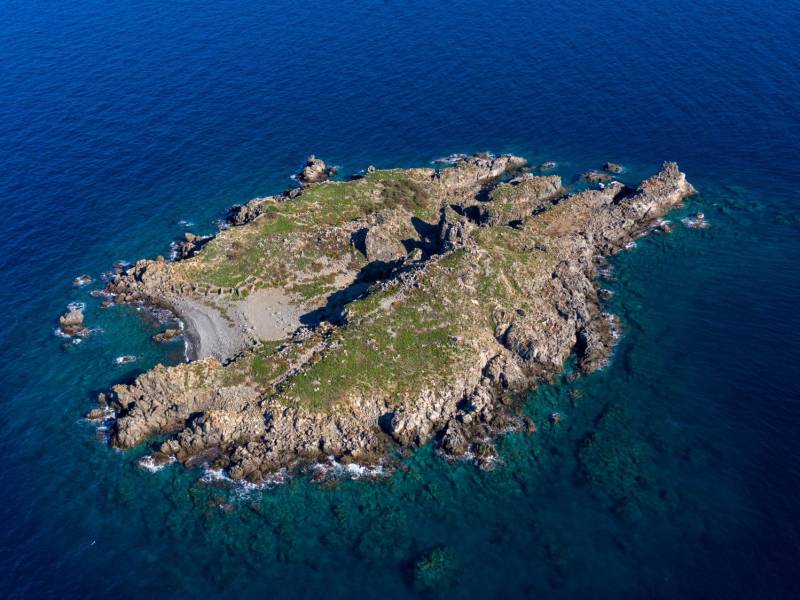
Surrounding islands
Provided by:
Grad Komiža

In the middle of the blue Adriatic, far from the mainland, four islands of special power and stories emerge from the sea. Svetac, once a lively fishing island, preserves the memory of life in harsh conditions and the struggle of man with the sea. Brusnik and Jabuka, born from fire, are unique in their magmatic origin and black rocks that protrude from the open sea like sculptures. Brusnik slowly "grows" from the sea, while Jabuka, resembling a black pyramid, defies everything, offering no shelter to a single ship. The most distant and largest of them, Palagruža, has been a landmark for sailors for centuries, a mythical place of ancient stories and the scene of numerous shipwrecks. These islands are not just geographical points on the map - they are natural monuments, witnesses of geological processes, fishing ventures and maritime legends. Each of them tells a different story, and together they form a unique whole - the black pearls of the open sea, the precious heritage of the Adriatic.
Points of interest

#1
Bisevo
Just five kilometers southwest of the island of Vis, hidden behind the Biševo Channel, lies Biševo – a small but distinctive island that has captured the imagination of travelers and the curious for centuries. Its hilly terrain culminates in Stražbenica, a 239-meter-high hill from which the view encompasses the entire open-sea horizon. The name Biševo is associated with the Italian word busi, which means holes, and in the Komiža dialect, “bišovo” means a worm-eaten tree. Just as such a tree is full of cavities, Biševo is an island of caves, pits and underground secrets. Prehistoric findings confirm that life has existed on Biševo since ancient times, but the last century brought about a great change. At the beginning of the 20th century, the island was alive and inhabited, and in 1961 it had 115 inhabitants. Today, according to the 2011 census, only about fifteen people live on the island. With the departure of the population, the vineyard terraces, fields and olive groves disappeared, and nature took over. Instead of the cultivated landscape, today, macchia, garrigue and Aleppo pine forests prevail. The biggest challenge for Biševo has become the question of how to bring back life and restore anthropogenic values, while at the same time preserving its precious natural features. Biševo is best known for its caves. The biggest attraction of the Adriatic is certainly the Blue Cave, a magical blue hall in which the refraction and reflection of sunlight from the seabed create an unreal play of light. This scene, in which the rocks and the sea take on surreal tones, remains etched in the memory of every visitor. Slightly wilder and more mysterious is the Medvidina špilja, once home to the Mediterranean monk seal – the “sea man”, the rarest seal in the world. But Biševo is also an island of beaches, fine sand and crystal clear sea. The coves of Mezoporat, Porat and Salbunara offer peace and hedonism, while the evenings bring one of the clearest night skies on the Adriatic. The stars then hang over Biševo as if they were within reach, and every visitor feels that they are in a place where nature, history and silence breathe the same breath. Biševo is a small island, but with a story bigger than itself – a story of life, disappearance and the eternal beauty that remains.

#2
Svetac (Saint Andrew)
Fourteen nautical miles west of Komiža, in the middle of the open sea, lies Svetac or Sveti Andrija – an island of rugged cliffs and legends, once lively and inhabited, and today silent and deserted. With an area of 4.6 km² and no natural harbor, it has always been inaccessible, but it is precisely this wild inaccessibility that makes it special. Tin Ujević described it in his 1930 travelogue Teuta’s Palace as “the last edge of the Adriatic”. Svetac has been inhabited since prehistoric times. In Roman times, an important shipping route passed through here, and legend has it that the Illyrian queen Teuta built a fortress on its heights, which is why the island is sometimes called Teuta’s. From the 11th to the 15th centuries, Benedictines lived here, and their church of St. Andrew still stands on the southern slopes today. In the second half of the 18th century, the Zanchi family (now Zanki) from Italy moved to the island, producing resin for Venetian shipyards. Their descendants are still connected to Svetac. Life on the island has always been difficult. The sea is rich in fish, but unpredictable and dangerous; winds could lift rocks, and the cliffs hid numerous accidents and shipwrecks. Children were once lowered down steep cliffs to hunt seabirds, terns, and falcons, so that something more than fish could be on the table. Svetac had its largest population in 1952 – 72. The island's natural uniqueness is as impressive as its history. Svetac, along with Brusnik and Jabuk, is part of UNESCO's global network of geoparks. It is known for its rare bird colonies, endemic plants, and as many as 28 caves, some of which shimmer with blue, such as the famous Blue Cave on Biševo. At the beginning of the 20th century, the Zanki family built several large stone houses on Svec for a dozen families, after previously living in caves themselves. Today, their windows are only opened occasionally, mostly in the summer, when one of their descendants comes to pick capers, tend to the vineyard, or guide a rare visitor through the island's desert. In winter, when the sea closes off the approaches and the winds take over the island, only the hardiest remain on Svec – a few donkeys and cats, silent guardians of the solitude on the last edge of the Adriatic.

#3
Jabuka
Like a dark pyramid emerging from the depths, Jabuka rises 30 nautical miles west of Komiža. At 97 meters high and with a circumference of about 700 meters, this islet, built of deep-sea igneous rock called diabase, has been a geological monument of nature since 1958. Jabuka is harsh and untamable. It has no bays, no docks, and offers no shelter to any boat. Its smooth rocks are not eaten away by the sea, but polished, so that even a rope cannot be securely tied. The deep seabed makes anchoring difficult, and the magnetite in the rocks disrupts compasses - which makes sailing near it particularly dangerous in poor visibility. Despite this, for centuries, Komiža fishermen have dared to come here. In winter, they used their falkuša to catch fish and crabs in the rich seabed, exposing themselves to the bora, storms, and the dangers of the open sea. They could not stay on the island itself, but they still left a trace – about twenty toponyms that still bear witness to their presence today. Jabuka is also home to rare wildlife. The Jabuka black lizard lives on its rocks, and the endemic species Centaurea jabukensis and Centaurea chritmifolia grow among the plants. Black, lonely and inaccessible, Jabuka stands at the far edge of the eastern Adriatic – like a stone sentinel, a guardian of the sea desert and a silent witness to the courage of the fishermen who dared to sail to it.

#4
Palagruza
The most remote and geologically oldest island archipelago in the Adriatic, Palagruža has always aroused admiration and respect. Located almost in the middle of the Adriatic Sea, this group of islands and rocks preserves natural, historical and mythical stories, and the small islet of Galijula marks the southernmost point of Croatian territory. The central place is occupied by Vela Palagruža, 1400 meters long, 300 meters wide and 90 meters high. On its peak in 1875, Austria-Hungary built a lighthouse that still guides ships through the open sea. A narrow hiking trail winds around the island, and on the south side is Velo Žalo beach – one of the most beautiful pebble beaches in the Adriatic, recognizable by the mother-of-pearl stones that shape the sea. Palagruža was a key point on maritime routes in prehistoric and ancient times. It is believed that ancient writers knew it as the Diomedes Islands, and perhaps it was here that a sanctuary dedicated to the hero Diomedes was located. Archaeological research has uncovered fragments of Greek pottery, evidence of the trade and cult that flourished here for centuries. But Palagruža’s most dramatic stories are tied to the sea. Its underwater world is a veritable treasure trove of archaeological finds – from ancient shipwrecks with amphorae and lead ingots, to Venetian ships with cannons, to the remains of the Italian submarine Nereide, sunk in 1915. Particularly dangerous was the Pupak Shoal, just four miles to the east, an underwater trap that has swallowed numerous ships. Vela Palagruža also contains the remains of a late-antique fortress and a Roman lighthouse, part of the signaling system that ensured navigation in the Adriatic in the 5th century. Wild and remote, Palagruža is at once a natural gem, an archaeological treasure trove and a mythical place, a guardian of the border between sea and history – an island where legends, shipwrecks and endless horizons of the open sea merge.

#5
Brusnik
Thirteen nautical miles southwest of Komiža, in the middle of the open sea, the black islet of Brusnik rises from the sea. At 23 meters high, 200 meters long and 150 meters wide, it is small but unique – along with Jabuka, it is the only Adriatic island built of igneous rocks. Unlike the Komiža volcanics, which were formed by the cooling of lava on the rim of an ancient volcano, Brusnik was formed by the crystallization of magma at depth as it traveled to the surface. Geologically, Brusnik is a wonder. Its conglomerates reveal that the island is still rising, and the shores, filled with gray diabase pebbles and covered with algae, create the impression of an extraterrestrial landscape. That is why it is often said that Brusnik is not just an island, but also a natural chronicle of the origin of the world. However, Brusnik does not only preserve the story of fire and stone. In its center is a gorge with a natural depression filled with sea. Komiža fishermen used larger pebbles to make pools for storing their caught lobsters, and on the large beach of black pebbles they built houses made of the same material. Covered with pine branches from Svec, they served as shelter from the sun and wind and as places where bluefish were salted in barrels. Thus, this small islet became the stage for two stories: geological, millions of years old, and fishing, which has shaped the lives of Komiža residents for centuries. In winter, lobsters intended for European metropolises were caught here, long before tourism reached our islands. Brusnik is also home to several endemic species, the most famous of which is the Brusnik black lizard. Due to its exceptional geological and natural value, the islet was declared a geological monument of nature in 1951 – a rarity among Adriatic islands, as most of them are formed from limestone, and not from rocks born “from fire”. Small, black and harsh, Brusnik still stands as a silent witness today – an island that grows and in its story combines the power of nature and the perseverance of man.